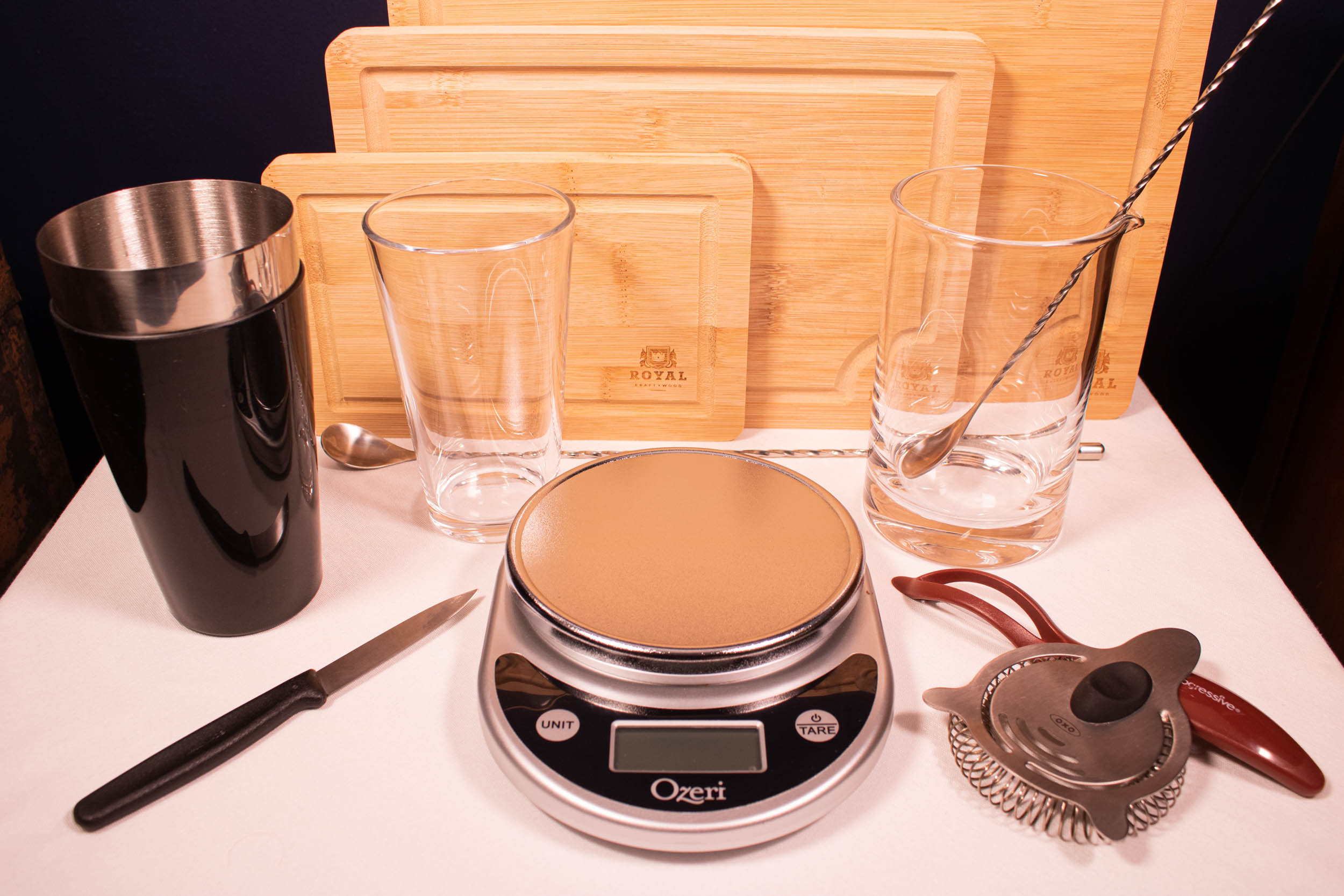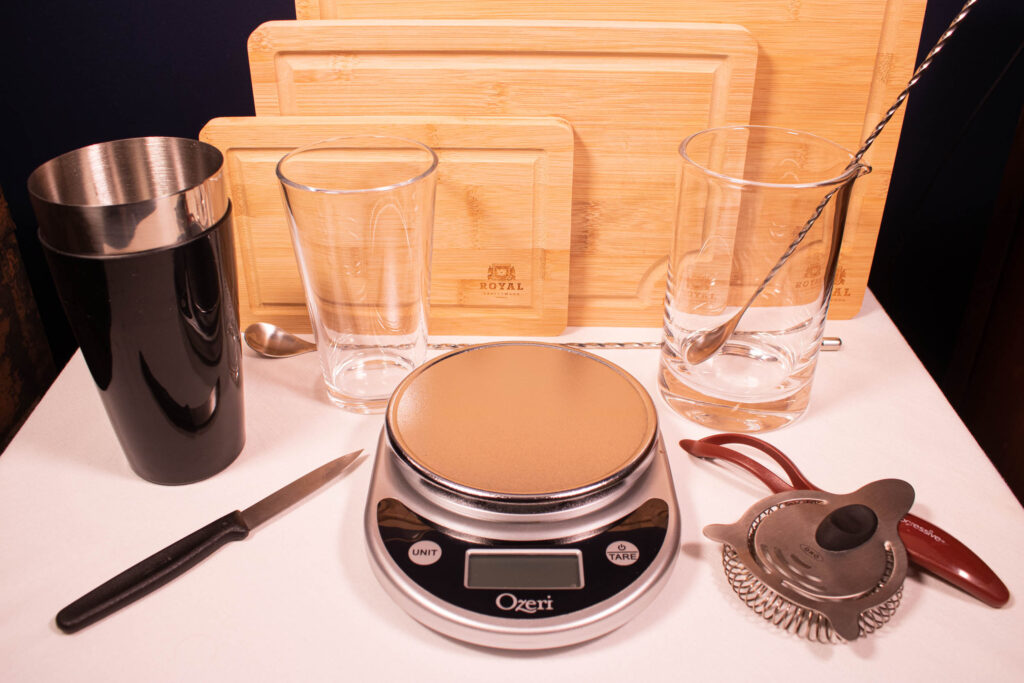
You could buy a lot of equipment to start making cocktails, but thankfully you only need a few tools to get started. While our recommended equipment for beginning a home bar isn’t going to put you into mixologist-perfect territory, we’re going to try to keep you from needing an arm and a leg. Remember, you can always expand your collection of tools as you find you enjoy a particular type of cocktail.
Our tools are broken down into the following sections:
- Measuring
- Crafting
- Straining
- Garnishing
- Infusion
As a reminder – this list is setup as a bare-minimum list of tools. There are points you will find we use additional tools (almost always – such as a Chinois) that are not detailed in this guide.
Disclaimer: This post contains affiliate links to get you to the product. We may receive a small amount of the proceeds from your purchase. This helps keep First Pour Cocktails running, and bringing you new cocktails, reviews, and guides.
Recommended Equipment for Beginning a Home Bar
- Scale
- Hand Juicer / Citrus Juicer
- Boston Shaker
- Mixing Vessel
- Bar Spoon
- Hawthorne Strainer
- Paring Knife
- Vegetable Peeler
- Cutting Board
- Sauce Pot
Measuring
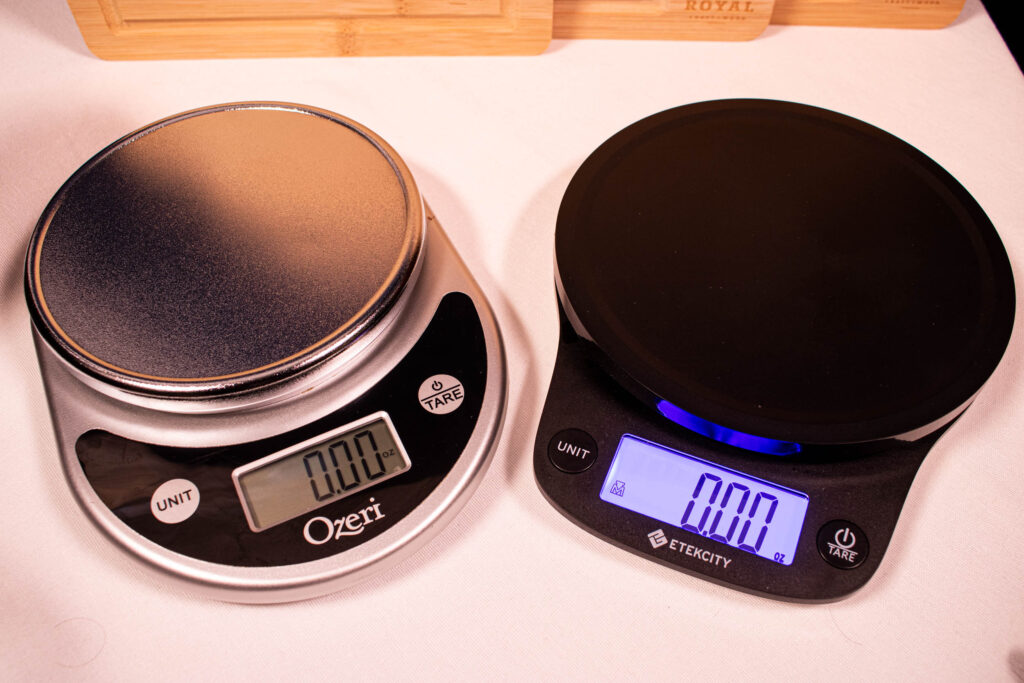
Scale: While this may be controversial, our first tool is not a pony / jigger. Rather, we utilize a scale. The reason behind using a scale is based on precision. With a scale you can measure down to smaller increments (down to a tenth of a gram depending on the precision of your scale). While the scale might not be as fast, we’re not aiming for speed, we’re aiming to make great drinks at home. If you’d like to speed up with the scale, consider adding a jigger or speed pourer.
Recommended Scales:
Both our recommended scales passed the nickel test to verify accuracy. The Etekcity has slightly more lag, but is more precise than the Ozeri. Both have proven durable in over a year of testing.
Crafting
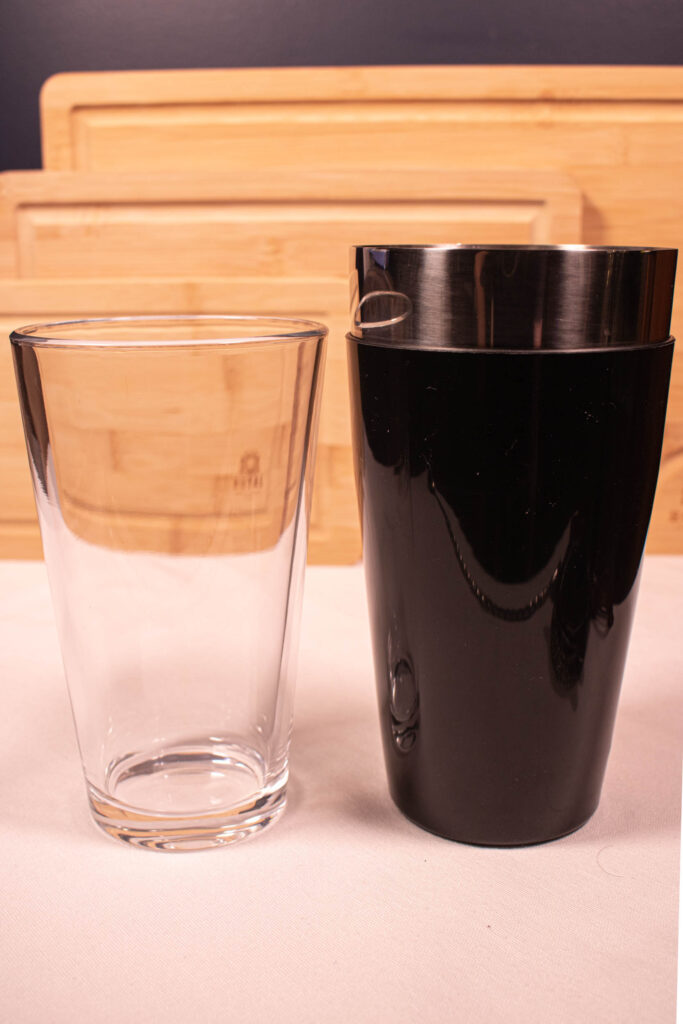
Boston Shaker: There are three kinds of shaker available, but the most practical is a Boston Shaker. This two piece construction is comprised of shaker tin and a pint glass (or smaller tin). This construction makes it easy to clean, easy to shake, and has less parts to break. While some individuals have trouble with the metal tin getting to cold, there are models with insulated tins.
Recommended Boston Shaker: Barsic’s Insulated 26/16 Boston Shaker
This shaker features insulation which increases comfort, while still offering a roomy 26/16 shaker combination. Be sure to knock the area with the palm of your hand where the glass and the tin begin to separate to release the vacuum.
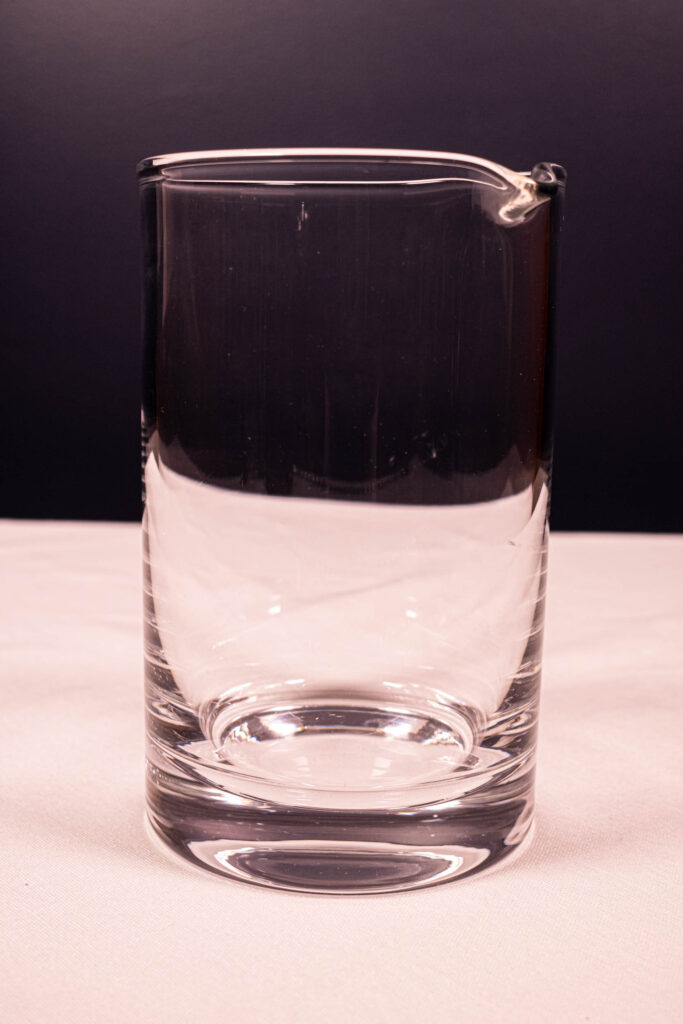
Mixing Vessel: Technically, could stir in a shaking tin or pint glass. Although nothing bad would come of this, it’s not ideal for making a drink for a variety of reasons. From an aesthetic perspective, its not particularly attractive and the shaker tin won’t allow your guests to see what’s in your tin. The secondary, more nerdy, reason is that thermal mass of the glass is significantly different at distributing heat than a pint glass or a tin. This will change the amount of dilution occurring in your drink (which will reduce the amount of heat transfer from your hand through the metal).
There are multiple aesthetic styles of mixing vessel ranging from plane glass to crystal. These changes are primarily personal preference.
Recommended Mixing Vessel: Barfly 24 oz Mixing Glass
Brand isn’t the most important feature when it comes to a mixing glass, but rather thickness, reviews, and size. While you can buy smaller mixing vessels [ranging from 500 – 600 ml – like this one from Mixologists that we purchased and quite like], we find they’re not as effective at doing more than one drink as their 700ml / 24 oz cousins. For those reasons, we recommend you buy a larger vessel if you ever envision making more than one drink at a time. We’ve also had good luck at our local Crate and Barrel, if you have one near by (which is where our pictured glass comes from).
Hand Juicer / Citrus Juicer: For juicing citrus you could go over the top and buy an elaborate setup, but for most home bar applications, you won’t need the ability to juice 50 lemons. Most of the time you might need to juice a couple of lemons, limes, or oranges. The best tools to do this are hand juicers or manual citrus juicers.
Recommended Juicer: Amco Enameled Aluminum Lemon Squeezer
We Know the Amco has a bit of dodgy history in the Amazon reviews, but if you get a good (real) cast iron model, the things are built to last (mine is going strong since 2012). For this reason, we still recommend them.
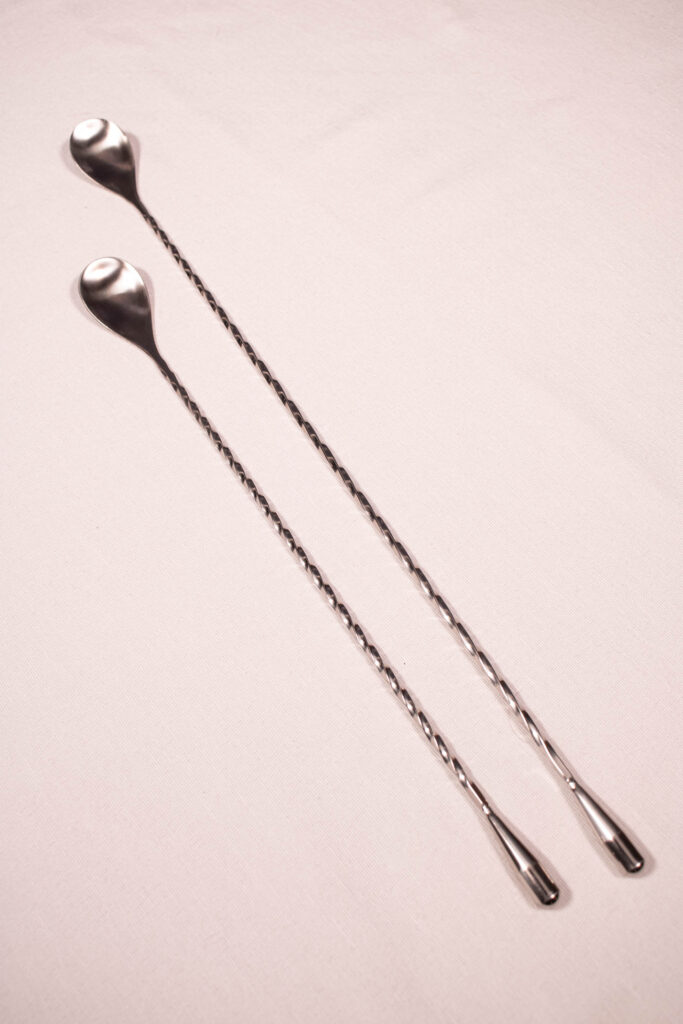
Bar Spoon: This sounds silly, but you really should invest in at least one bar spoon to stir your cocktail with. Bar spoons aren’t the conventional spoons you have in your kitchen, but rather they have twisted (or spiral) handles. The reason for the spiral is that as you twirl the spoon around the glass, the spoon will rotate smoothly between your fingers. If you were to use a conventional spoon, the broad handle will twist lengthwise between your fingers – resulting in a choppy and very unpleasant experience.
Bar spoons also have the advantage of being significantly longer than a standard spoon. This allows you more handle to grab outside of the mixing glass, providing more control to the user.
Just remember you don’t have to spend a lot to get a decent bar spoon. We’ve happily used a set of Purefolds from Amazon that cost about $7 for two different length spoons.
Recommended Bar Spoon: Purefolds 15.7″ / 12″ Bar Spoon Set
Straining
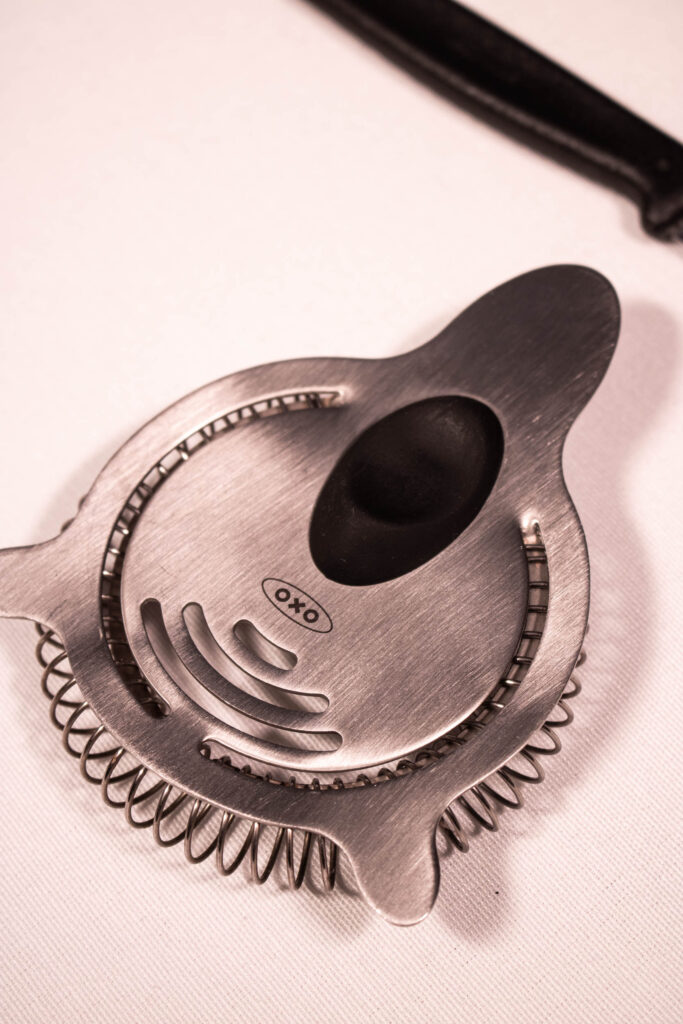
Hawthorne Strainer: Hawthorne strainers are the best choice when starting your home bar. They are made up of a top plate and a bottom spring. Thanks to their construction, they give you the ability to regulate the amount of filtration that is occurring when pouring your drink. This is accomplished by pushing the strainer forward to slide the top piece down, while the bottom piece contracts. This will hold back any large pieces from escaping the strainer.
The downside to a Hawthorne strainer is that it has the tendency to allow small ice chips and particles through. If you find yourself annoyed by the tiny ice chips or need to remove smaller pieces of muddled fruit, we recommend you invest in a conical strainer to double strain your drinks.
Recommended Hawthorne Strainer: Oxo Steel Cocktail Strainer
Garnishing
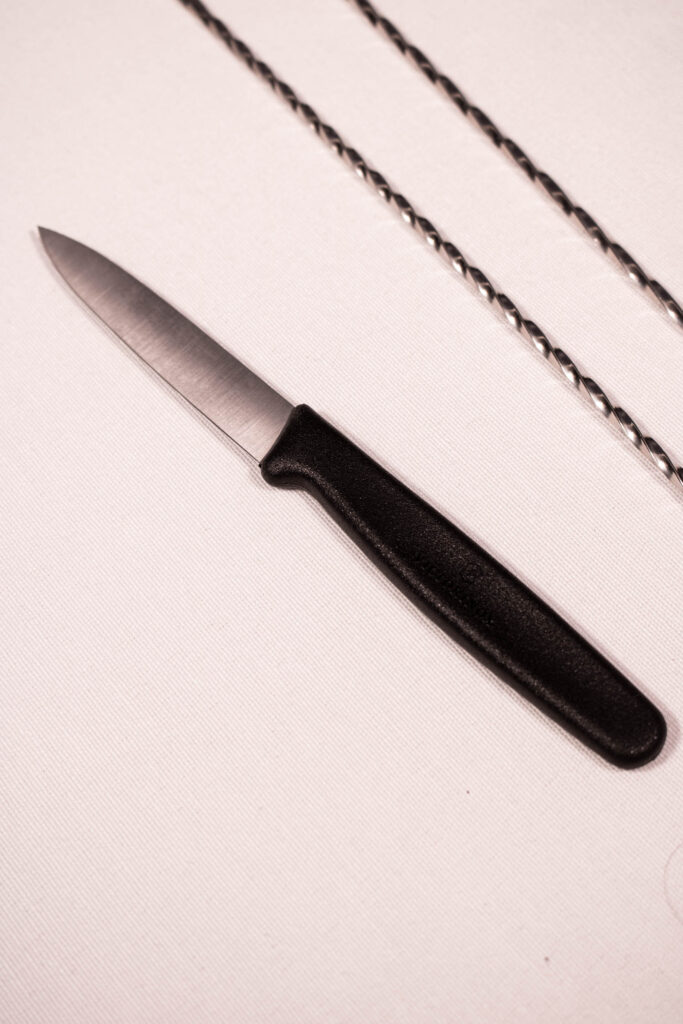
Paring Knife: Most of the items you’re going to be cutting are relatively small, so there’s no need to grab an 8″ chef’s knife. For day to day lemons and limes a paring knife is all you need, and they can be had cheap. The price isn’t the only reason to invest in a paring knife. The smaller knife is less to maneuver, and therefore easier to handle when doing intricate garnish work.
Recommended Pairing Knife: Victronix Straight Paring Knife, Large Handle
We like this knife so much we actually bought a second one. They’re dependable, hold an edge well, and won’t break the bank.
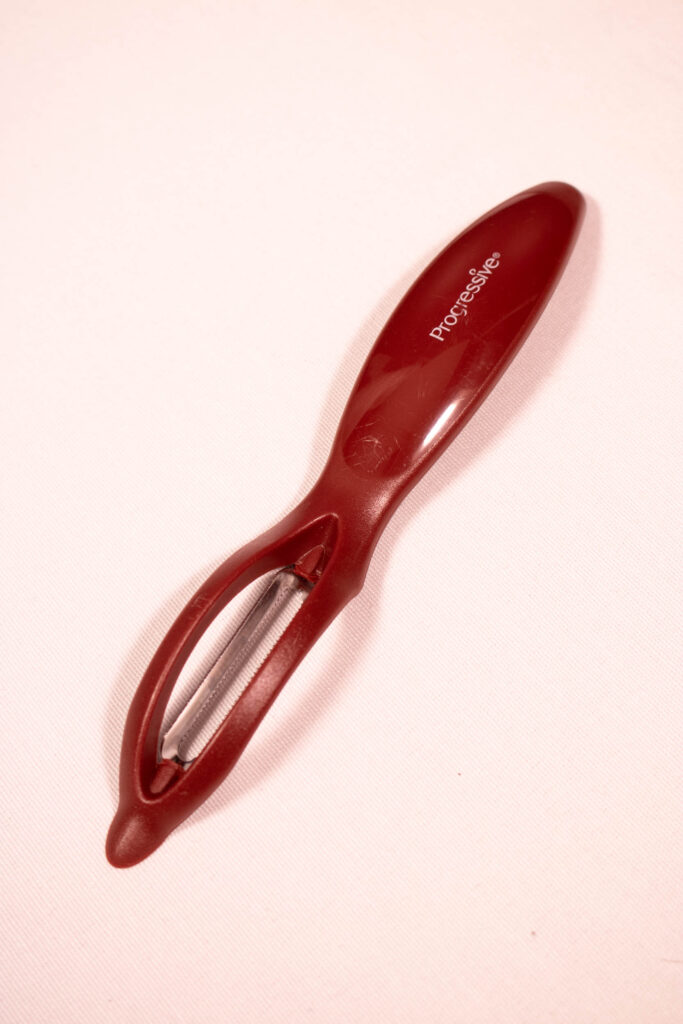
Vegetable Peeler: Vegetable peelers aren’t 100% essential if you happen to be great with your paring knife (and want to go through the trouble of trying to peel your citrus for garnish). If you happen to find you’re less than godly with a paring knife, the best course of action is to buy a vegetable peeler (if you don’t already have one). The peeler makes quick work of garnishing lemon and lime twists, and you’re (more likely to) get to keep your fingers in one piece.
Recommended Vegetable Peeler: Prepworks by Progressive Magnetic Peelers – Set of 3
We originally bought this peeler set for the kitchen, it works just fine, and won’t break the bank. Plus they stick together.
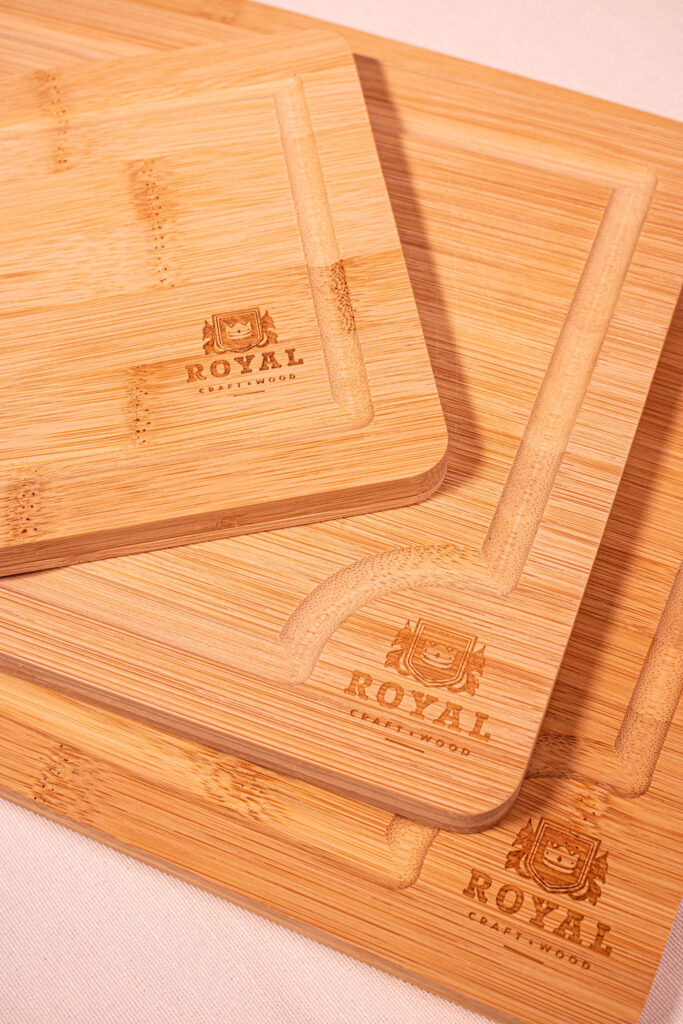
Cutting Board: Cutting boards don’t need to be big and fancy and to be effective. We prefer wood or bamboo cutting boards to help reduce the impact on our knives, and for the overall aesthetic. Due to the way plastic cutting boards tend to get scratched and stained, we do not recommend using them for your cocktail making. Finally, best practice is to avoid using your cutting board for any potentially hazardous substances (such as uncooked meat) if you plan to use it for your bar application. If you only have one cutting board, be sure to properly clean it with soap and water.
For our bar, we bought the multipack bamboo set listed below. This gives us the flexibility to use the larger cutting boards when making more drinks and the smaller board when only making a couple.
Recommended Cutting Board: Royal Craft Bamboo Cutting Board 3 Pack
Infusion
Sauce Pot: While you can make simple syrup by shaking water and sugar together for extended duration, the use of heat short circuits the process and leads to consistent results. To make simple syrup on the stove, you’ll want something you likely already have in your kitchen, a sauce pot. Stainless steel is recommended for the best results.
Using heat adds a secondary benefit, as it allows you to infuse flavors (such as cinnamon) into a syrup
Recommended Sauce Pot: Tramontina 3 Qt Stainless Steel
This is our pot at home and it’s been a work horse the last 5 years for everything from rice to syrups.
So How Much Is The Basic Equipment to Setup My Home Bar Going To Cost?
While each piece of equipment you’ll need to setup your home bar is relatively inexpensive, they do add up. Our list of equipment is designed to be durable enough that you should only really need buy this equipment once (or if you drop a glass / mixing vessel or years down the road). We’ve totaled the list in two different ways, one without a cutting board and sauce pot, and one with. The reason is that these items are relatively more expensive, and likely to already be in your kitchen. Without these items, the list ends up at $100 (as of August 2021).
| Equipment | Recommendation | Cost (List Price) |
|---|---|---|
| Scale | Ozeri ZK14-S Pronto Digital Multifunction Kitchen and Food Scale | $15 |
| Juicer | Amco Enameled Aluminum Lemon Squeezer | $10 |
| Boston Shaker | Barsic’s Insulated 26/16 Boston Shaker | $15 |
| Mixing Vessel | Barfly 24 oz Mixing Glass | $21 |
| Bar Spoon | Purefolds 15.7″ / 12″ Bar Spoon Set | $10 |
| Hawthorne Strainer | Oxo Steel Cocktail Strainer | $9 |
| Paring Knife | Victronix Straight Paring Knife, Large Handle | $8 |
| Vegetable Peeler | Prepworks by Progressive Magnetic Peelers – Set of 3 | $12 |
| Cutting Board | Royal Craft Bamboo Cutting Board 3 Pack | $25 |
| Sauce Pot | Tramontina 3 Qt Stainless Steel | $90 |
| Total (without Sauce Pan / Cutting Board) | $100 | |
| Total | $215 |

Now that you’ve got the Recommended Equipment for a Beginning a Home Bar, let’s get setup with the Recommended Bottles for Beginning a Home Bar!
